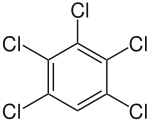Pentachlorobenzene (PeCB) is an aryl chloride and a five-substituted chlorobenzene with the molecular formula C6HCl5 which is a chlorinated aromatic hydrocarbon. It consists of a benzene ring substituted with five chlorine atoms. PeCB was once used industrially for a variety of uses, but because of environmental concerns there are currently no large scale uses of PeCB.[4] Pentachlorobenzene is a known persistent organic pollutant (POP) and banned globally by the Stockholm Convention on Persistent Organic Pollutants in 2009.[5]

| |
| Names | |
|---|---|
| Preferred IUPAC name
Pentachlorobenzene | |
| Other names
PeCB
| |
| Identifiers | |
3D model (JSmol)
|
|
| 1911550 | |
| ChEBI | |
| ChEMBL | |
| ChemSpider | |
| ECHA InfoCard | 100.009.248 |
| EC Number |
|
| 51144 | |
| KEGG | |
PubChem CID
|
|
| RTECS number |
|
| UNII | |
CompTox Dashboard (EPA)
|
|
| |
| |
| Properties | |
| C6HCl5 | |
| Molar mass | 250.32 g·mol−1 |
| Appearance | White or colorless crystals |
| Density | 1.8 g/cm3[1] |
| Melting point | 86 °C (187 °F; 359 K)[1] |
| Boiling point | 275 to 277 °C (527 to 531 °F; 548 to 550 K)[1] |
| 0.68 mg/L[2] | |
| Hazards | |
| GHS labelling: | |
  
| |
| Danger | |
| H228, H302, H410 | |
| P210, P240, P241, P264, P270, P273, P280, P301+P312, P330, P370+P378, P391, P501 | |
| Lethal dose or concentration (LD, LC): | |
LD50 (median dose)
|
rat: 1080 mg/kg[3] mouse: 1175 mg/kg[3] |
Except where otherwise noted, data are given for materials in their standard state (at 25 °C [77 °F], 100 kPa).
| |
Production
editPeCB can be produced as a byproduct of the manufacture of carbon tetrachloride and benzene. It is extracted by distillation and crystallization. The direct production of pure PeCB is not practical because of the simultaneous production of other chlorinated compounds. Since PeCB is generally produced in small quantities in the chlorination of benzene, it is also contained in other chlorobenzenes (dichlorobenzenes, trichlorobenzenes etc.)
Today, a majority of the PeCB released into the environment is a result of backyard trash burning and municipal waste incineration.[4]
Uses
editPeCB was used as an intermediate in the manufacture of pesticides, particularly the fungicide pentachloronitrobenzene.[3] Pentachloronitrobenzene is now made by the chlorination of nitrobenzene in order to avoid the use of PeCB.[4]
PeCB was a component of a mixture of chlorobenzenes added to products containing polychlorinated biphenyls in order to reduce viscosity.[4] PeCB has also been used as a fire retardant.[3]
Safety and regulation
editPeCB is a persistent organic pollutant, allowing an accumulation in the food chain.[1][4] Consequently, pentachlorobenzene was added in 2009 to the list of chemical compounds covered by the Stockholm Convention, an international treaty which restricts the production and use of persistent organic pollutants.[6][7] PeCB has been banned in the European Union since 2002.
PeCB is very toxic to aquatic organisms, and decomposes on heating or on burning with the formation of toxic, corrosive fumes including hydrogen chloride.[1] Combustion of PeCB may also result in the formation of polychlorinated dibenzodioxins ("dioxins") and polychlorinated dibenzofurans.
See also
edit- Chlorobenzenes—different numbers of chlorine substituents
- Pentafluorobenzene
- Pentachlorobenzenethiol
References
edit- ^ a b c d e Pentachlorobenzene Safety Card, International Programme on Chemical Safety
- ^ Shen, L., Wania, F., Lei, Y. D., Teixeira, C., Muir, D. C. G., Bidleman, T. F. (2005). "Compilation, evaluation, and selection of physical-chemical property data for organochlorine pesticides". J. Chem. Eng. Data. 50 (3): 742–768. doi:10.1021/je049693f.
{{cite journal}}: CS1 maint: multiple names: authors list (link) - ^ a b c d Pentachlorobenzene Fact Sheet, U.S. Environmental Protection Agency[dead link]
- ^ a b c d e Pentachlorobenzene – Sources, environmental fate and risk characterization Archived 2008-12-27 at the Wayback Machine, Robert E. Bailey, EuroChlor, July 2007
- ^ Press Release – COP4 – Geneva, 8 May 2009: Governments unite to step-up reduction on global DDT reliance and add nine new chemicals under international treaty, 2009.
- ^ Governments unite to step-up reduction on global DDT reliance and add nine new chemicals under international treaty, Stockholm Convention on Persistent Organic Pollutants, 9 May 2009
- ^ Adding the 'Nasty Nine' to the 'Dirty Dozen' Archived 2013-12-06 at the Wayback Machine, thedailygreen.com